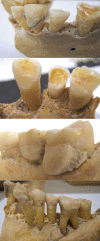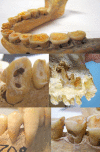The prevalence of periodontal disease in a Romano-British population c. 200-400 AD
- PMID: 25342357
- PMCID: PMC4340975
- DOI: 10.1038/sj.bdj.2014.908
The prevalence of periodontal disease in a Romano-British population c. 200-400 AD
Abstract
Objective: The aim of this study was to investigate the prevalence of moderate to severe periodontitis in an ancient British cohort c. 200-400 AD.
Design: Observational study to assess periodontal and other oral disease parameters.
Setting: Natural History Museum, London.
Subjects and methods: 303 skulls from a Romano-British burial site in Poundbury, Dorset were examined for evidence of dental disease.
Main outcome measures: The primary outcome measure was presence of moderate to severe periodontitis. Secondary outcomes included: amount of horizontal bone loss; prevalence of ante-mortem tooth loss; and presence of other dental pathologies.
Results: The overall prevalence of moderate to severe periodontitis was just greater than 5%. The prevalence rate remained nearly constant between ages 20 to 60, after which it rose to around 10%. The number of affected teeth increased with age. Horizontal bone loss was generally minor. Caries was seen in around 50% of the cohort, and evidence of pulpal and apical pathology was seen in around 25%.
Conclusions: The prevalence of moderate to severe periodontitis was markedly decreased when compared to the prevalence in modern populations, underlining the potential importance of risk factors such as smoking and diabetes in determining susceptibility to progressive periodontitis in modern populations.
Figures





References
-
- Papapanou P N. Epidemiology of periodontal diseases: an update. J Int Acad Periodontol 1999; 1: 110–116. - PubMed
-
- Loe H, Anerud A, Boysen H, Morrison E. Natural history of periodontal disease in man. Rapid, moderate and no loss of attachment in Sri Lankan laborers 14 to 46 years of age. J Clin Periodontol 1986; 13: 431–445. - PubMed
-
- Baelum V, Pisuithanakan S, Teanpaisan R et al.. Periodontal conditions among adults in Southern Thailand. J Periodontal Res 2003; 38: 156–163. - PubMed
-
- Holtfreter B, Schwahn C, Biffar R, Kocher T. Epidemiology of periodontal diseases in the study of health in Pomerania. J Clin Periodontol 2009; 36: 114–123. - PubMed
-
- Norderyd O, Hugoson A. Risk of severe periodontal disease in a Swedish adult population. A cross-sectional study. J Clin Periodontol 1998; 25: 1022–1028. - PubMed
Publication types
MeSH terms
LinkOut - more resources
Full Text Sources
Other Literature Sources

